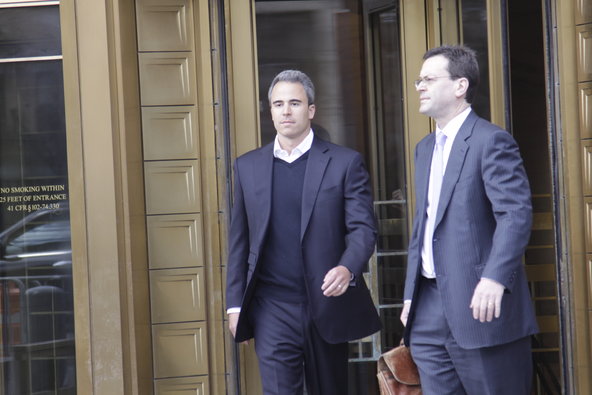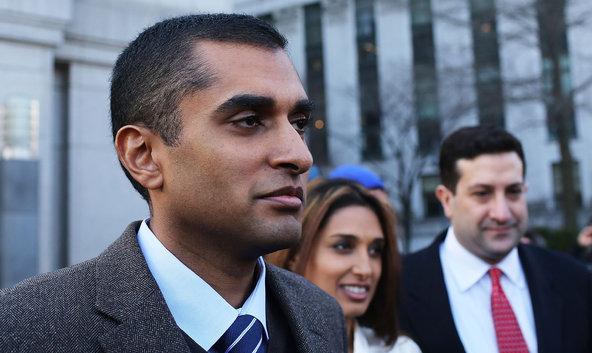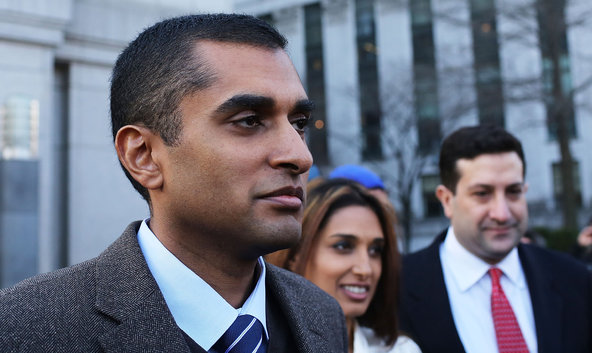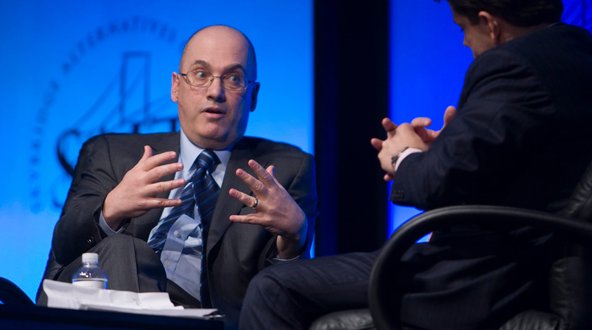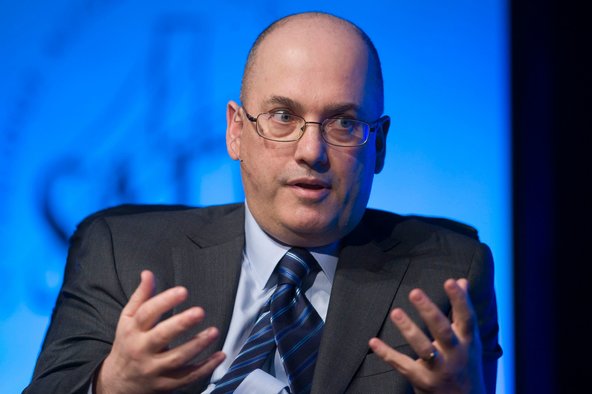 Steve Marcus/ReutersSteven Cohen, founder of the hedge fund SAC Capital Advisors.
Steve Marcus/ReutersSteven Cohen, founder of the hedge fund SAC Capital Advisors.
As government investigators closed in on the billionaire hedge fund manager Steven A. Cohen in recent years, his defenders argued that the unusual structure of his firm, SAC Capital Advisors, shielded him from any illegal trading by his employees.
Mr. Cohen, they said, sat atop a sprawling, decentralized operation in which about 140 small teams were each given hundreds of millions of dollars to invest. These teams had almost complete autonomy, so if they were crossing the line, Mr. Cohen would not know about it.
But in a detailed legal filing on Friday, federal regulators made their case that Mr. Cohen was not only well aware of suspicious trading activity at SAC but participated in it. Piecing together phone records, e-mails and instant messages, the Securities and Exchange Commission’s filing painted Mr. Cohen as a boss deeply engaged in his employees’ questionable behavior.
“Faced with red flags of potentially unlawful conduct by employees under his supervision, Cohen allowed his traders to execute the recommended trades and stood by,” the S.E.C. said.
Related Links
 Documents: S.E.C.’s Civil Charges
Documents: S.E.C.’s Civil Charges Graphic: Insider Cases |
Graphic: Insider Cases |  Video
Video- Under New Chief, a Feistier S.E.C. Emerges (July 19, 2013)
- S.E.C. Charges Are Latest Test for Steven Cohen (July 19, 2013)
The information in the S.E.C. filing could provide additional ammunition for federal prosecutors and the F.B.I., who continue to build a criminal case against SAC. Among the actions being contemplated by the Justice Department is bringing a broad conspiracy charge against the fund itself, accusing it of multiple acts of insider trading over a period of years.
The S.E.C. case also adds detail on Mr. Cohen’s role in his firm’s buildup of large stakes in two drug makers, the subject of a separate criminal case, including the first mention of input from a former SAC employee who is now a hedge fund manager.
In an appearance last week at an investment conference sponsored by the cable news channel CNBC, Preet Bharara, the United States attorney in Manhattan, whose office is investigating SAC, refused to answer specific questions about Mr. Cohen and his firm.
But speaking broadly about hedge funds, Mr. Bharara said that some firms paid “lip service” to compliance, adding that those with multiple violations over a period of time must be held accountable. While noting that charging a company with a crime was a “rare use of power,” Mr. Bharara told the interviewer, Jim Cramer, that he was not opposed to doing so.
“I don’t see anyone that’s too big to indict,” Mr. Bharara said. “No one is too big to jail.”
The civil action brought by the S.E.C. does not accuse Mr. Cohen of insider trading or securities fraud, but with failing to supervise his employees. And it was filed not as a lawsuit in federal court, but as an administrative proceeding that will be heard by an administrative law judge at the S.E.C. If the commission prevails, possible penalties against Mr. Cohen include a permanent ban from the financial services industry.
Though the case is the first time the government has personally accused Mr. Cohen of wrongdoing, it adds to a raft of criminal and civil insider trading cases involving SAC over the last three years. Four former SAC employees have pleaded guilty; five others have been tied to illicit activity. The fund agreed this year to pay a record $616 million penalty to settle two S.E.C. lawsuits related to insider trading.
The crush of cases has imperiled SAC, which Mr. Cohen started in 1992 and now has more than 1,000 employees. Many investors in the $15 billion fund have pulled their money since the beginning of the year. They have asked to withdraw roughly two-thirds of the $6 billion in outside funds managed by SAC. The rest of firm’s assets — about $9 billion — are mostly Mr. Cohen’s. The next quarterly deadline to make a withdrawal request is Aug. 15. Losing outside capital costs SAC dearly, because the fund charges its investors among the industry’s highest fees on the strength of its superior performance.
An SAC spokesman said Mr. Cohen, 57, at all times acted appropriately and would fight the charges. He also noted that the commission was ignoring SAC’s “extensive compliance policies and procedures.”
Yet the S.E.C.’s filing depicts Mr. Cohen and his employees operating free of any interference by SAC’s compliance department. The case, which focuses entirely on trading in 2008, the only year SAC lost money, highlights a number of dubious communications between Mr. Cohen and his staff members.
In one instance, Mr. Cohen received an e-mail in which an SAC analyst explicitly said he had received financial information from a person inside the computer maker Dell for three consecutive quarters and then provided detailed numbers about the company in advance of its coming earnings announcement. After receiving the e-mail, Mr. Cohen sold his entire 500,000-share position in Dell, the S.E.C. said.
The filing seeks to show that Mr. Cohen was aware that his staff was possibly gleaning secrets from classic inside sources like an executive at a publicly traded company and doctors involved with clinical trials for a promising new drug. S.E.C. lawyers say such information would have caused any reasonable hedge fund manager to investigate possible wrongdoing and take reasonable steps to prevent it, which is what the government must show to prove its case.
“The standard of proof is substantially lower here than with an insider trading charge, which would require showing knowledge or recklessness,” said Paul Huey-Burns, a former S.E.C. lawyer now in private practice. “A failure-to-supervise case requires only a showing of negligence, that Mr. Cohen was essentially careless in his oversight of the firm.”
In the past, Mr. Cohen, who owns 100 percent of SAC, has acknowledged a lack of familiarity with the firm’s compliance and ethics policies on insider trading. In a deposition he gave in 2011 connected with a lawsuit unrelated to the S.E.C.’s case, Mr. Cohen said, “I’ve read the compliance manual, but I don’t remember exactly what it says.” He also called the rules on what constituted inside information “very vague.”
As the investigation escalated earlier this year, Mr. Cohen tried to send a message to investors and regulators that he and his firm took compliance seriously. He announced changes to bolster SAC’s compliance practices, including holding back the pay of those accused of wrongdoing and increasing the compliance department by 25 percent, to about 40 employees. In 2008, by contrast, the firm had just 10 people in its compliance department.
The S.E.C. filing details how Mr. Cohen encouraged employees to elicit information from a doctor involved in clinical trials. It also rounds out information concerning SAC’s controversial positions in the stocks of the drug makers Elan and Wyeth.
Mathew Martoma, a former SAC portfolio manager, was charged last year with securities fraud for illegally selling Elan and Wyeth shares in advance of negative news about a promising Alzheimer’s drug that was being developed by the two companies. Prosecutors said he had obtained confidential information about the drug from a doctor involved in its clinical trials. The government said Mr. Martoma traded on the information, helping SAC earn profits and avoid losses totaling $276 million.
Mr. Martoma has pleaded not guilty and is set to stand trial in November. The doctor, Sidney Gilman, has agreed to testify against Mr. Martoma in exchange for not being prosecuted.
The S.E.C.’s case provides additional information on Mr. Cohen’s role in SAC’s accumulation of large positions in Elan and Wyeth. In addition to relying on Mr. Martoma’s advice, Mr. Cohen, according to the S.E.C., received input on the companies from a former SAC employee referred to only as “Hedge Fund Manager A.”
The hedge fund manager is Wayne Holman, according to people briefed on the case. Mr. Holman, a health care stock specialist, was one of SAC’s highest-paid employees, earning more than $100 million before leaving in 2006 to start his own hedge fund, Ridgeback Capital Management, these people said.
Inside SAC, there was much internal debate over the soundness of holding such big, risky positions in Elan and Wyeth in advance of the impending announcement of the clinical trial’s results. After an analyst sent Mr. Cohen an instant message questioning the holdings, Mr. Cohen responded that he was following the advice of Mr. Martoma and Mr. Holman because “they are closer to it than you,” according to the court filing.
The analyst then replied to Mr. Cohen, “[I] don’t know if [Hedge Fund Manager A] or mat [Martoma] will answer, but do you think they know something or do they have a very strong feeling.”
Mr. Cohen replied: “[T]ough one … i think mat [Martoma] is the closest to it.”
Mr. Holman has not been accused of any wrongdoing. Bud G. Holman, Mr. Holman’s father and Ridgeback’s general counsel, did not return requests for comment.
A version of this article appeared in print on 07/22/2013, on page B1 of the NewYork edition with the headline: Case Reveals Cohen’s Links to Dubious Actions at SAC.
Article source: http://dealbook.nytimes.com/2013/07/21/s-e-c-case-reveals-cohens-links-to-dubious-actions-at-sac/?partner=rss&emc=rss
